Ethics and HRM: Exploring Utilitarianism and Happiness in HRM
VerifiedAdded on 2020/05/01
|7
|1940
|572
Essay
AI Summary
This essay provides a comprehensive exploration of ethics in Human Resource Management (HRM), focusing on the ethical theory of utilitarianism and its implications for the workplace. It begins by defining utilitarianism, its core principles, and the happiness principle as proposed by Jeremy Bentham and John Stuart Mill. The essay then delves into the concept of HRM, its functions, and its relation to the happiness of employees. It explores the importance of moral economy and ethical business practices. The essay concludes by emphasizing the role of HRM in promoting ethical goals and creating a positive work environment by following the happiness principle, arguing that ethical business should be a priority and benefit the greatest number of employees. The paper includes references to key scholars and their works, supporting the arguments presented throughout the essay.
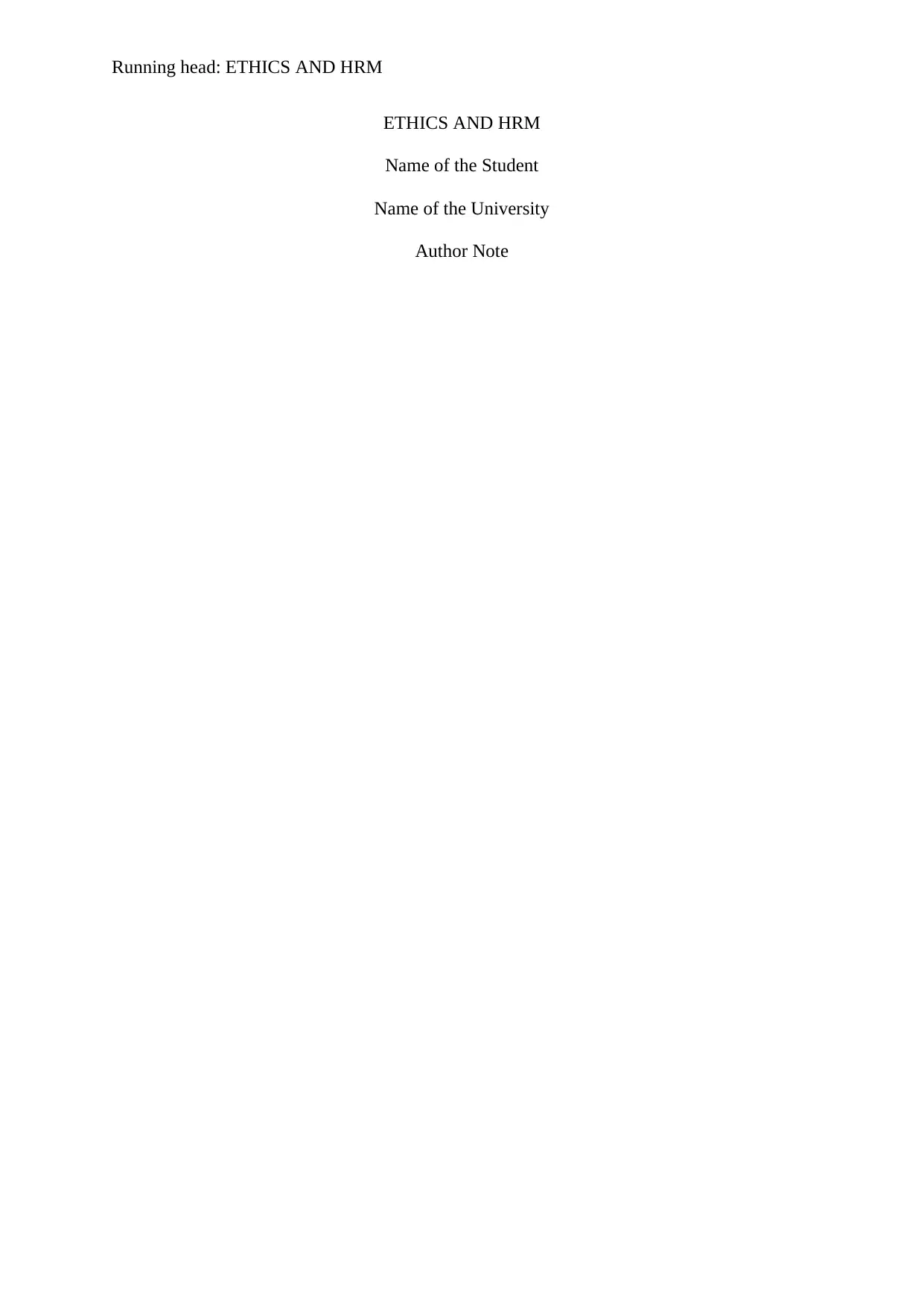
Running head: ETHICS AND HRM
ETHICS AND HRM
Name of the Student
Name of the University
Author Note
ETHICS AND HRM
Name of the Student
Name of the University
Author Note
Paraphrase This Document
Need a fresh take? Get an instant paraphrase of this document with our AI Paraphraser
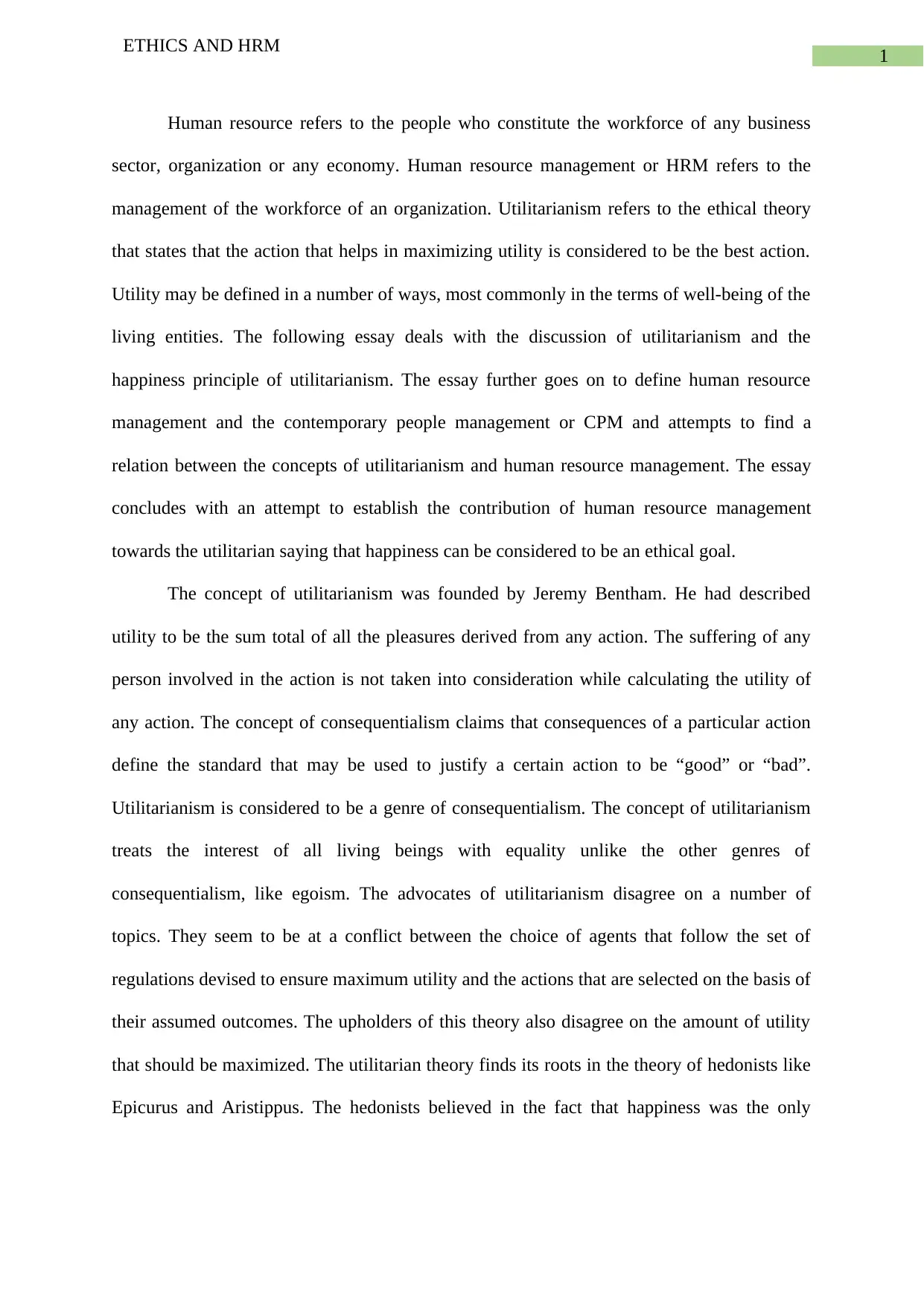
1
ETHICS AND HRM
Human resource refers to the people who constitute the workforce of any business
sector, organization or any economy. Human resource management or HRM refers to the
management of the workforce of an organization. Utilitarianism refers to the ethical theory
that states that the action that helps in maximizing utility is considered to be the best action.
Utility may be defined in a number of ways, most commonly in the terms of well-being of the
living entities. The following essay deals with the discussion of utilitarianism and the
happiness principle of utilitarianism. The essay further goes on to define human resource
management and the contemporary people management or CPM and attempts to find a
relation between the concepts of utilitarianism and human resource management. The essay
concludes with an attempt to establish the contribution of human resource management
towards the utilitarian saying that happiness can be considered to be an ethical goal.
The concept of utilitarianism was founded by Jeremy Bentham. He had described
utility to be the sum total of all the pleasures derived from any action. The suffering of any
person involved in the action is not taken into consideration while calculating the utility of
any action. The concept of consequentialism claims that consequences of a particular action
define the standard that may be used to justify a certain action to be “good” or “bad”.
Utilitarianism is considered to be a genre of consequentialism. The concept of utilitarianism
treats the interest of all living beings with equality unlike the other genres of
consequentialism, like egoism. The advocates of utilitarianism disagree on a number of
topics. They seem to be at a conflict between the choice of agents that follow the set of
regulations devised to ensure maximum utility and the actions that are selected on the basis of
their assumed outcomes. The upholders of this theory also disagree on the amount of utility
that should be maximized. The utilitarian theory finds its roots in the theory of hedonists like
Epicurus and Aristippus. The hedonists believed in the fact that happiness was the only
ETHICS AND HRM
Human resource refers to the people who constitute the workforce of any business
sector, organization or any economy. Human resource management or HRM refers to the
management of the workforce of an organization. Utilitarianism refers to the ethical theory
that states that the action that helps in maximizing utility is considered to be the best action.
Utility may be defined in a number of ways, most commonly in the terms of well-being of the
living entities. The following essay deals with the discussion of utilitarianism and the
happiness principle of utilitarianism. The essay further goes on to define human resource
management and the contemporary people management or CPM and attempts to find a
relation between the concepts of utilitarianism and human resource management. The essay
concludes with an attempt to establish the contribution of human resource management
towards the utilitarian saying that happiness can be considered to be an ethical goal.
The concept of utilitarianism was founded by Jeremy Bentham. He had described
utility to be the sum total of all the pleasures derived from any action. The suffering of any
person involved in the action is not taken into consideration while calculating the utility of
any action. The concept of consequentialism claims that consequences of a particular action
define the standard that may be used to justify a certain action to be “good” or “bad”.
Utilitarianism is considered to be a genre of consequentialism. The concept of utilitarianism
treats the interest of all living beings with equality unlike the other genres of
consequentialism, like egoism. The advocates of utilitarianism disagree on a number of
topics. They seem to be at a conflict between the choice of agents that follow the set of
regulations devised to ensure maximum utility and the actions that are selected on the basis of
their assumed outcomes. The upholders of this theory also disagree on the amount of utility
that should be maximized. The utilitarian theory finds its roots in the theory of hedonists like
Epicurus and Aristippus. The hedonists believed in the fact that happiness was the only
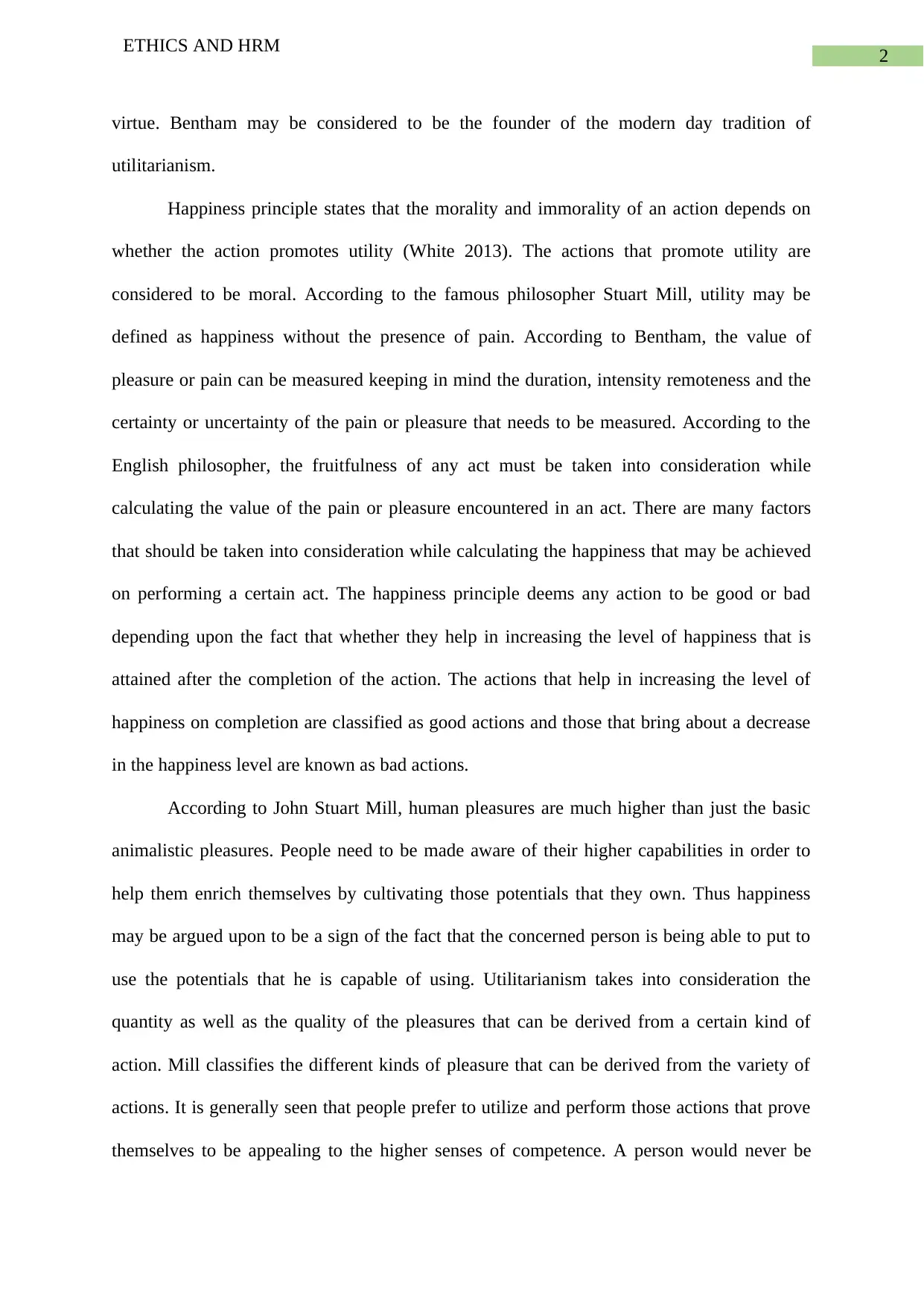
2
ETHICS AND HRM
virtue. Bentham may be considered to be the founder of the modern day tradition of
utilitarianism.
Happiness principle states that the morality and immorality of an action depends on
whether the action promotes utility (White 2013). The actions that promote utility are
considered to be moral. According to the famous philosopher Stuart Mill, utility may be
defined as happiness without the presence of pain. According to Bentham, the value of
pleasure or pain can be measured keeping in mind the duration, intensity remoteness and the
certainty or uncertainty of the pain or pleasure that needs to be measured. According to the
English philosopher, the fruitfulness of any act must be taken into consideration while
calculating the value of the pain or pleasure encountered in an act. There are many factors
that should be taken into consideration while calculating the happiness that may be achieved
on performing a certain act. The happiness principle deems any action to be good or bad
depending upon the fact that whether they help in increasing the level of happiness that is
attained after the completion of the action. The actions that help in increasing the level of
happiness on completion are classified as good actions and those that bring about a decrease
in the happiness level are known as bad actions.
According to John Stuart Mill, human pleasures are much higher than just the basic
animalistic pleasures. People need to be made aware of their higher capabilities in order to
help them enrich themselves by cultivating those potentials that they own. Thus happiness
may be argued upon to be a sign of the fact that the concerned person is being able to put to
use the potentials that he is capable of using. Utilitarianism takes into consideration the
quantity as well as the quality of the pleasures that can be derived from a certain kind of
action. Mill classifies the different kinds of pleasure that can be derived from the variety of
actions. It is generally seen that people prefer to utilize and perform those actions that prove
themselves to be appealing to the higher senses of competence. A person would never be
ETHICS AND HRM
virtue. Bentham may be considered to be the founder of the modern day tradition of
utilitarianism.
Happiness principle states that the morality and immorality of an action depends on
whether the action promotes utility (White 2013). The actions that promote utility are
considered to be moral. According to the famous philosopher Stuart Mill, utility may be
defined as happiness without the presence of pain. According to Bentham, the value of
pleasure or pain can be measured keeping in mind the duration, intensity remoteness and the
certainty or uncertainty of the pain or pleasure that needs to be measured. According to the
English philosopher, the fruitfulness of any act must be taken into consideration while
calculating the value of the pain or pleasure encountered in an act. There are many factors
that should be taken into consideration while calculating the happiness that may be achieved
on performing a certain act. The happiness principle deems any action to be good or bad
depending upon the fact that whether they help in increasing the level of happiness that is
attained after the completion of the action. The actions that help in increasing the level of
happiness on completion are classified as good actions and those that bring about a decrease
in the happiness level are known as bad actions.
According to John Stuart Mill, human pleasures are much higher than just the basic
animalistic pleasures. People need to be made aware of their higher capabilities in order to
help them enrich themselves by cultivating those potentials that they own. Thus happiness
may be argued upon to be a sign of the fact that the concerned person is being able to put to
use the potentials that he is capable of using. Utilitarianism takes into consideration the
quantity as well as the quality of the pleasures that can be derived from a certain kind of
action. Mill classifies the different kinds of pleasure that can be derived from the variety of
actions. It is generally seen that people prefer to utilize and perform those actions that prove
themselves to be appealing to the higher senses of competence. A person would never be
⊘ This is a preview!⊘
Do you want full access?
Subscribe today to unlock all pages.

Trusted by 1+ million students worldwide
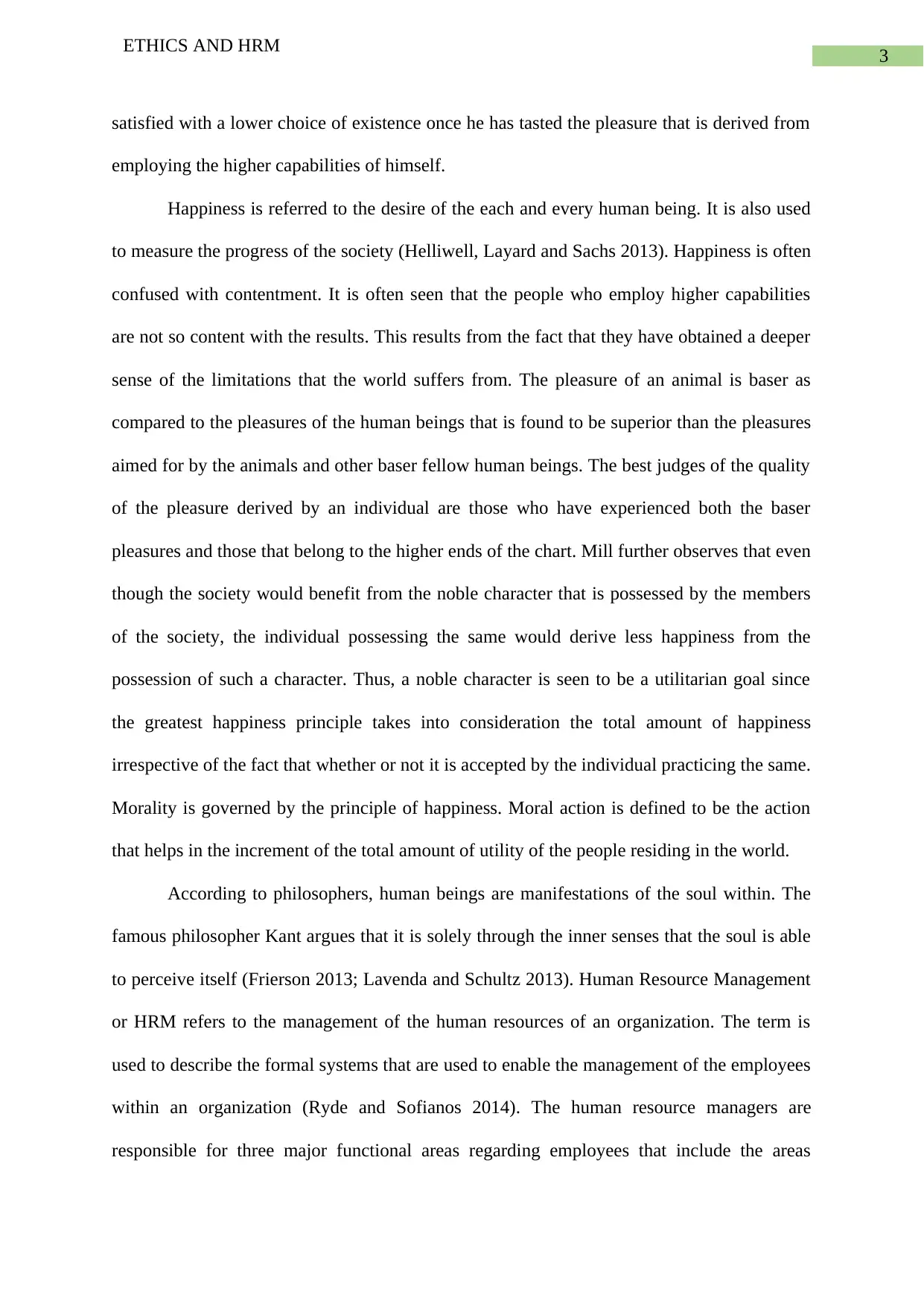
3
ETHICS AND HRM
satisfied with a lower choice of existence once he has tasted the pleasure that is derived from
employing the higher capabilities of himself.
Happiness is referred to the desire of the each and every human being. It is also used
to measure the progress of the society (Helliwell, Layard and Sachs 2013). Happiness is often
confused with contentment. It is often seen that the people who employ higher capabilities
are not so content with the results. This results from the fact that they have obtained a deeper
sense of the limitations that the world suffers from. The pleasure of an animal is baser as
compared to the pleasures of the human beings that is found to be superior than the pleasures
aimed for by the animals and other baser fellow human beings. The best judges of the quality
of the pleasure derived by an individual are those who have experienced both the baser
pleasures and those that belong to the higher ends of the chart. Mill further observes that even
though the society would benefit from the noble character that is possessed by the members
of the society, the individual possessing the same would derive less happiness from the
possession of such a character. Thus, a noble character is seen to be a utilitarian goal since
the greatest happiness principle takes into consideration the total amount of happiness
irrespective of the fact that whether or not it is accepted by the individual practicing the same.
Morality is governed by the principle of happiness. Moral action is defined to be the action
that helps in the increment of the total amount of utility of the people residing in the world.
According to philosophers, human beings are manifestations of the soul within. The
famous philosopher Kant argues that it is solely through the inner senses that the soul is able
to perceive itself (Frierson 2013; Lavenda and Schultz 2013). Human Resource Management
or HRM refers to the management of the human resources of an organization. The term is
used to describe the formal systems that are used to enable the management of the employees
within an organization (Ryde and Sofianos 2014). The human resource managers are
responsible for three major functional areas regarding employees that include the areas
ETHICS AND HRM
satisfied with a lower choice of existence once he has tasted the pleasure that is derived from
employing the higher capabilities of himself.
Happiness is referred to the desire of the each and every human being. It is also used
to measure the progress of the society (Helliwell, Layard and Sachs 2013). Happiness is often
confused with contentment. It is often seen that the people who employ higher capabilities
are not so content with the results. This results from the fact that they have obtained a deeper
sense of the limitations that the world suffers from. The pleasure of an animal is baser as
compared to the pleasures of the human beings that is found to be superior than the pleasures
aimed for by the animals and other baser fellow human beings. The best judges of the quality
of the pleasure derived by an individual are those who have experienced both the baser
pleasures and those that belong to the higher ends of the chart. Mill further observes that even
though the society would benefit from the noble character that is possessed by the members
of the society, the individual possessing the same would derive less happiness from the
possession of such a character. Thus, a noble character is seen to be a utilitarian goal since
the greatest happiness principle takes into consideration the total amount of happiness
irrespective of the fact that whether or not it is accepted by the individual practicing the same.
Morality is governed by the principle of happiness. Moral action is defined to be the action
that helps in the increment of the total amount of utility of the people residing in the world.
According to philosophers, human beings are manifestations of the soul within. The
famous philosopher Kant argues that it is solely through the inner senses that the soul is able
to perceive itself (Frierson 2013; Lavenda and Schultz 2013). Human Resource Management
or HRM refers to the management of the human resources of an organization. The term is
used to describe the formal systems that are used to enable the management of the employees
within an organization (Ryde and Sofianos 2014). The human resource managers are
responsible for three major functional areas regarding employees that include the areas
Paraphrase This Document
Need a fresh take? Get an instant paraphrase of this document with our AI Paraphraser
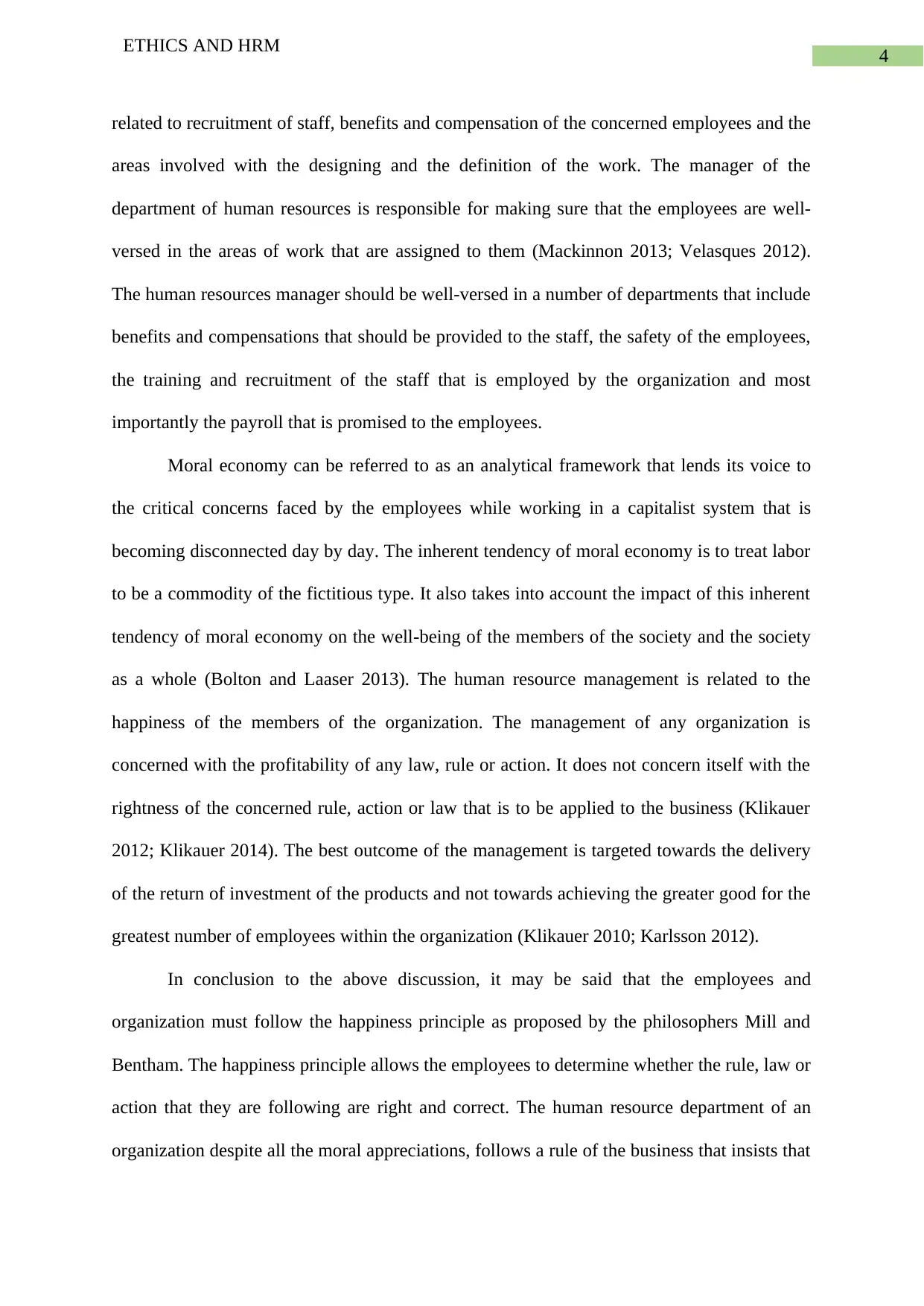
4
ETHICS AND HRM
related to recruitment of staff, benefits and compensation of the concerned employees and the
areas involved with the designing and the definition of the work. The manager of the
department of human resources is responsible for making sure that the employees are well-
versed in the areas of work that are assigned to them (Mackinnon 2013; Velasques 2012).
The human resources manager should be well-versed in a number of departments that include
benefits and compensations that should be provided to the staff, the safety of the employees,
the training and recruitment of the staff that is employed by the organization and most
importantly the payroll that is promised to the employees.
Moral economy can be referred to as an analytical framework that lends its voice to
the critical concerns faced by the employees while working in a capitalist system that is
becoming disconnected day by day. The inherent tendency of moral economy is to treat labor
to be a commodity of the fictitious type. It also takes into account the impact of this inherent
tendency of moral economy on the well-being of the members of the society and the society
as a whole (Bolton and Laaser 2013). The human resource management is related to the
happiness of the members of the organization. The management of any organization is
concerned with the profitability of any law, rule or action. It does not concern itself with the
rightness of the concerned rule, action or law that is to be applied to the business (Klikauer
2012; Klikauer 2014). The best outcome of the management is targeted towards the delivery
of the return of investment of the products and not towards achieving the greater good for the
greatest number of employees within the organization (Klikauer 2010; Karlsson 2012).
In conclusion to the above discussion, it may be said that the employees and
organization must follow the happiness principle as proposed by the philosophers Mill and
Bentham. The happiness principle allows the employees to determine whether the rule, law or
action that they are following are right and correct. The human resource department of an
organization despite all the moral appreciations, follows a rule of the business that insists that
ETHICS AND HRM
related to recruitment of staff, benefits and compensation of the concerned employees and the
areas involved with the designing and the definition of the work. The manager of the
department of human resources is responsible for making sure that the employees are well-
versed in the areas of work that are assigned to them (Mackinnon 2013; Velasques 2012).
The human resources manager should be well-versed in a number of departments that include
benefits and compensations that should be provided to the staff, the safety of the employees,
the training and recruitment of the staff that is employed by the organization and most
importantly the payroll that is promised to the employees.
Moral economy can be referred to as an analytical framework that lends its voice to
the critical concerns faced by the employees while working in a capitalist system that is
becoming disconnected day by day. The inherent tendency of moral economy is to treat labor
to be a commodity of the fictitious type. It also takes into account the impact of this inherent
tendency of moral economy on the well-being of the members of the society and the society
as a whole (Bolton and Laaser 2013). The human resource management is related to the
happiness of the members of the organization. The management of any organization is
concerned with the profitability of any law, rule or action. It does not concern itself with the
rightness of the concerned rule, action or law that is to be applied to the business (Klikauer
2012; Klikauer 2014). The best outcome of the management is targeted towards the delivery
of the return of investment of the products and not towards achieving the greater good for the
greatest number of employees within the organization (Klikauer 2010; Karlsson 2012).
In conclusion to the above discussion, it may be said that the employees and
organization must follow the happiness principle as proposed by the philosophers Mill and
Bentham. The happiness principle allows the employees to determine whether the rule, law or
action that they are following are right and correct. The human resource department of an
organization despite all the moral appreciations, follows a rule of the business that insists that
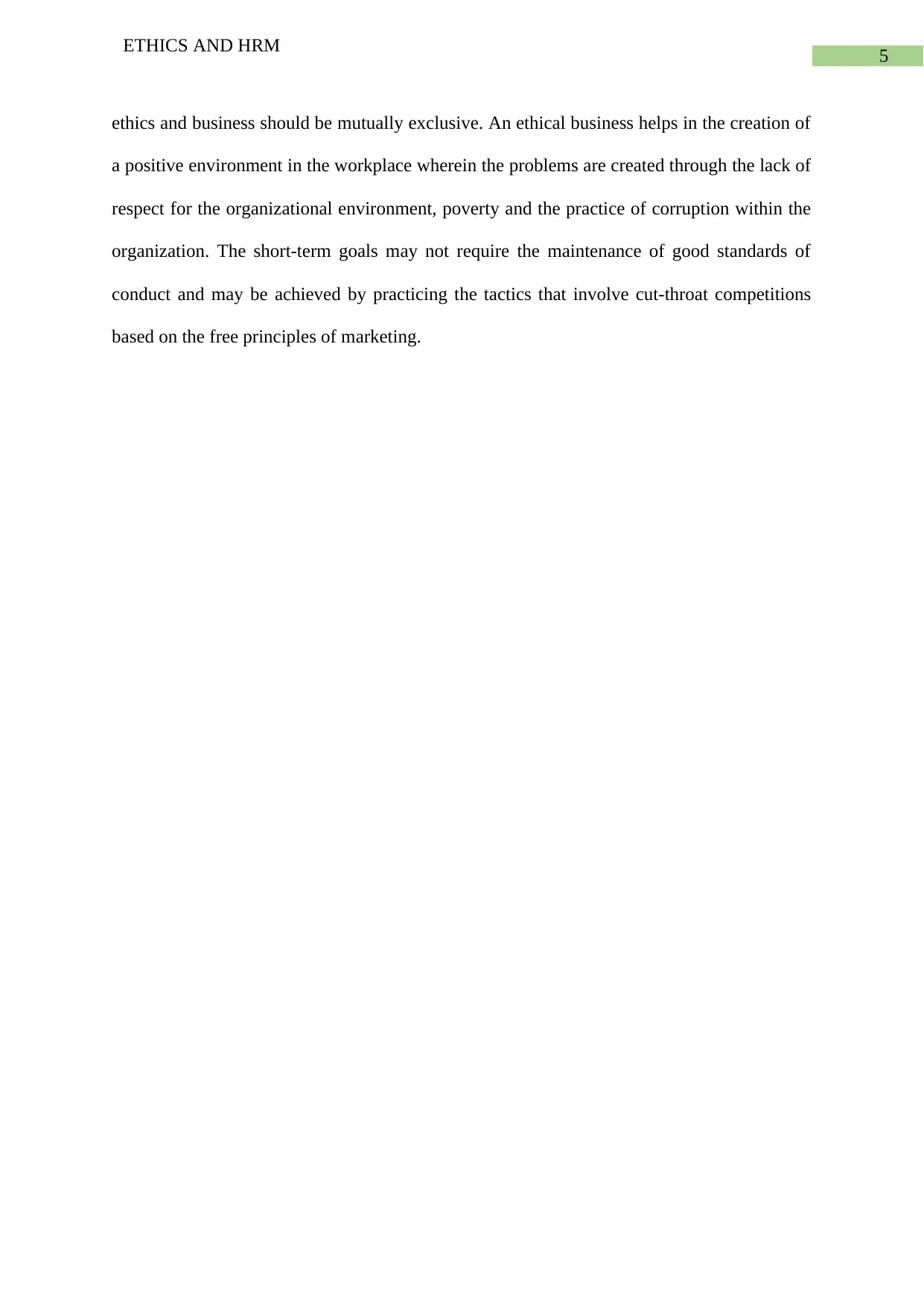
5
ETHICS AND HRM
ethics and business should be mutually exclusive. An ethical business helps in the creation of
a positive environment in the workplace wherein the problems are created through the lack of
respect for the organizational environment, poverty and the practice of corruption within the
organization. The short-term goals may not require the maintenance of good standards of
conduct and may be achieved by practicing the tactics that involve cut-throat competitions
based on the free principles of marketing.
ETHICS AND HRM
ethics and business should be mutually exclusive. An ethical business helps in the creation of
a positive environment in the workplace wherein the problems are created through the lack of
respect for the organizational environment, poverty and the practice of corruption within the
organization. The short-term goals may not require the maintenance of good standards of
conduct and may be achieved by practicing the tactics that involve cut-throat competitions
based on the free principles of marketing.
⊘ This is a preview!⊘
Do you want full access?
Subscribe today to unlock all pages.

Trusted by 1+ million students worldwide
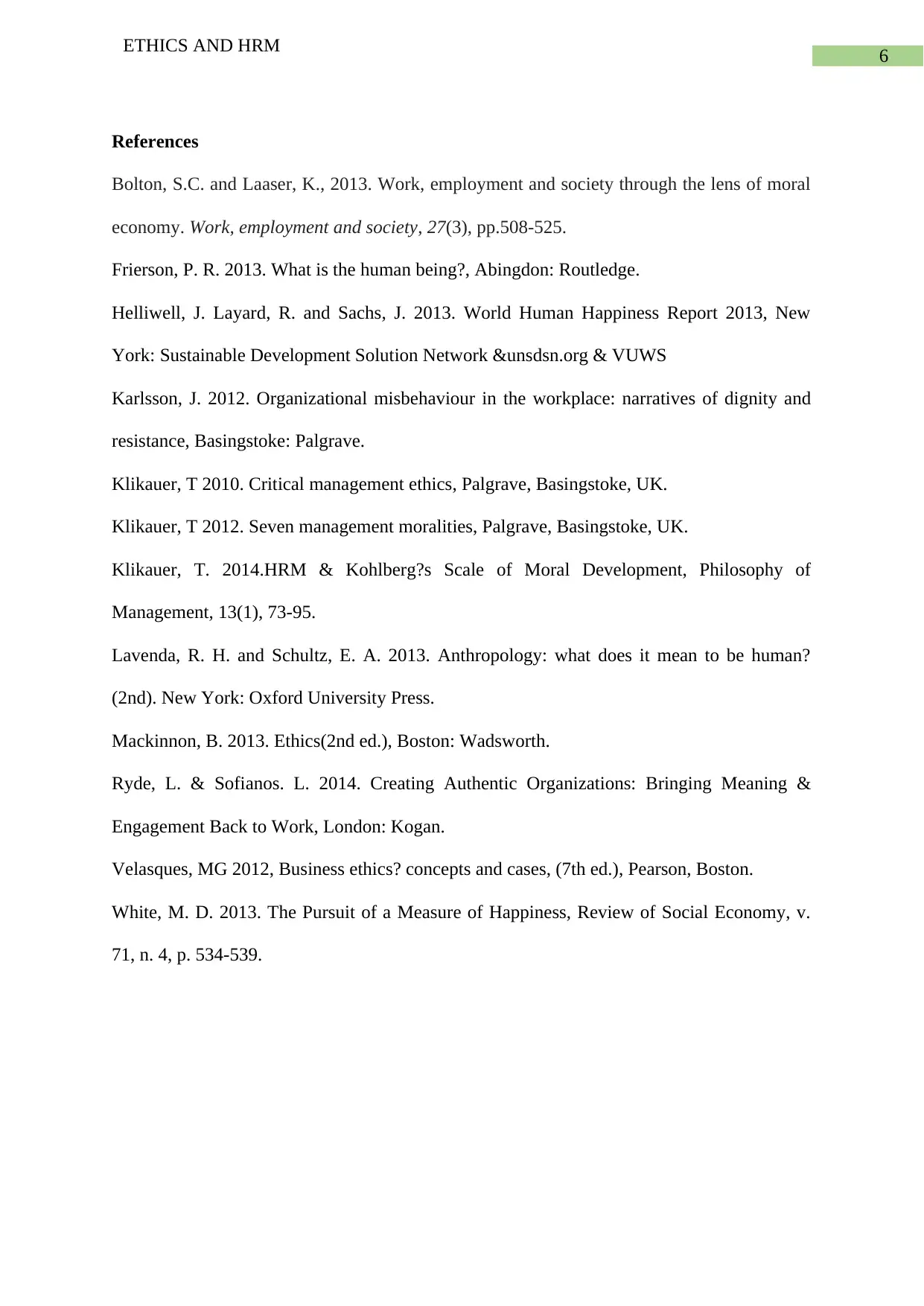
6
ETHICS AND HRM
References
Bolton, S.C. and Laaser, K., 2013. Work, employment and society through the lens of moral
economy. Work, employment and society, 27(3), pp.508-525.
Frierson, P. R. 2013. What is the human being?, Abingdon: Routledge.
Helliwell, J. Layard, R. and Sachs, J. 2013. World Human Happiness Report 2013, New
York: Sustainable Development Solution Network &unsdsn.org & VUWS
Karlsson, J. 2012. Organizational misbehaviour in the workplace: narratives of dignity and
resistance, Basingstoke: Palgrave.
Klikauer, T 2010. Critical management ethics, Palgrave, Basingstoke, UK.
Klikauer, T 2012. Seven management moralities, Palgrave, Basingstoke, UK.
Klikauer, T. 2014.HRM & Kohlberg?s Scale of Moral Development, Philosophy of
Management, 13(1), 73-95.
Lavenda, R. H. and Schultz, E. A. 2013. Anthropology: what does it mean to be human?
(2nd). New York: Oxford University Press.
Mackinnon, B. 2013. Ethics(2nd ed.), Boston: Wadsworth.
Ryde, L. & Sofianos. L. 2014. Creating Authentic Organizations: Bringing Meaning &
Engagement Back to Work, London: Kogan.
Velasques, MG 2012, Business ethics? concepts and cases, (7th ed.), Pearson, Boston.
White, M. D. 2013. The Pursuit of a Measure of Happiness, Review of Social Economy, v.
71, n. 4, p. 534-539.
ETHICS AND HRM
References
Bolton, S.C. and Laaser, K., 2013. Work, employment and society through the lens of moral
economy. Work, employment and society, 27(3), pp.508-525.
Frierson, P. R. 2013. What is the human being?, Abingdon: Routledge.
Helliwell, J. Layard, R. and Sachs, J. 2013. World Human Happiness Report 2013, New
York: Sustainable Development Solution Network &unsdsn.org & VUWS
Karlsson, J. 2012. Organizational misbehaviour in the workplace: narratives of dignity and
resistance, Basingstoke: Palgrave.
Klikauer, T 2010. Critical management ethics, Palgrave, Basingstoke, UK.
Klikauer, T 2012. Seven management moralities, Palgrave, Basingstoke, UK.
Klikauer, T. 2014.HRM & Kohlberg?s Scale of Moral Development, Philosophy of
Management, 13(1), 73-95.
Lavenda, R. H. and Schultz, E. A. 2013. Anthropology: what does it mean to be human?
(2nd). New York: Oxford University Press.
Mackinnon, B. 2013. Ethics(2nd ed.), Boston: Wadsworth.
Ryde, L. & Sofianos. L. 2014. Creating Authentic Organizations: Bringing Meaning &
Engagement Back to Work, London: Kogan.
Velasques, MG 2012, Business ethics? concepts and cases, (7th ed.), Pearson, Boston.
White, M. D. 2013. The Pursuit of a Measure of Happiness, Review of Social Economy, v.
71, n. 4, p. 534-539.
1 out of 7
Related Documents
Your All-in-One AI-Powered Toolkit for Academic Success.
+13062052269
info@desklib.com
Available 24*7 on WhatsApp / Email
![[object Object]](/_next/static/media/star-bottom.7253800d.svg)
Unlock your academic potential
Copyright © 2020–2025 A2Z Services. All Rights Reserved. Developed and managed by ZUCOL.





